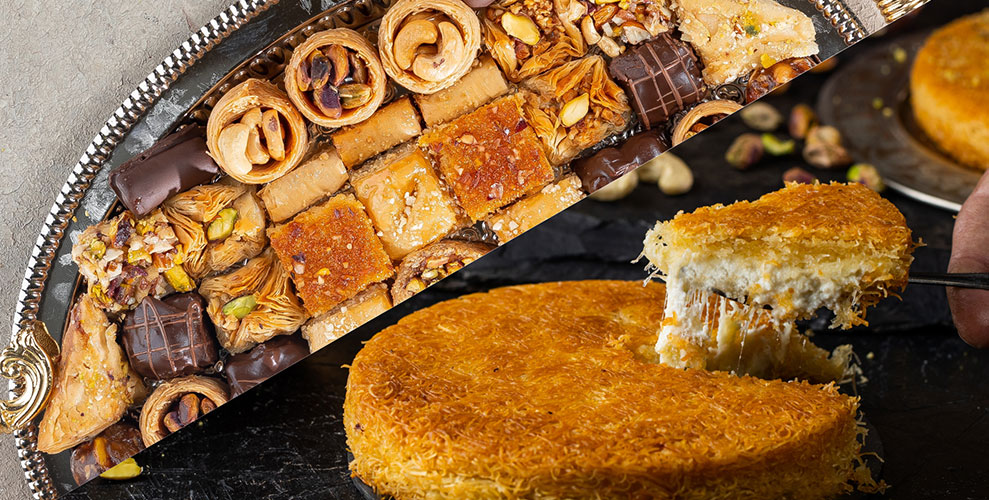
At Baklava Palace, we believe every sweet treat carries more than just flavor—it carries heritage, emotion, and memory. Among the many delights of Middle Eastern desserts, two names stand out as eternal favorites: baklava and kunafa. They may both be golden, syrup-kissed indulgences, yet they differ in origin, texture, taste, and the role they play in our celebrations.
In this article, we’ll take you through the story of Baklava vs. Kunafa: how they began, how they taste, what makes them unique, and why both hold a permanent place in the world of Middle Eastern traditions.
The Origins: A Journey Through Time
When discussing baklava vs. kunafa, we must first travel back to their roots.
The baklava’s origin is ancient, dating back nearly 3,000 years to the Assyrian Empire. Early versions of the dessert were layered with bread dough, nuts, and honey, baked over fire to create a rich indulgence reserved for royalty and the wealthy.
Over time, as it spread through the Middle East and beyond, this became a dessert of the people; beloved for its combination of crisp filo pastry, fragrant nuts, and sweet syrup. Today, it stands as one of the most recognized Middle Eastern desserts worldwide.
Kunafa, by contrast, emerged in the Levant. History ties it closely to the cities of Nablus and Jerusalem, where it became a celebratory dish enjoyed especially during Ramadan. Unlike baklava, which was known for its delicate pastry layers, kunafa’s distinction lies in its shredded dough or semolina crust, filled with stretchy cheese or cream. Warm and rich, this treat was always meant to be shared in large gatherings, symbolizing abundance and generosity.
At Baklava Palace, we honor these traditions by recreating them with authenticity, ensuring every bite reflects centuries of craftsmanship.
The Taste: Two Worlds of Fulfillment
When it comes to Baklava vs. Kunafa, taste is where the magic lies.
The former is all about balance. The filo pastry bakes into thin, golden layers of crispness that shatter gently with every bite. The nuts inside, may they be pistachios, walnuts, or cashews, add earthiness and crunch. While the syrup ties it all together with sweetness that lingers. The result is an indulgence that feels both light and rich, perfect for savoring slowly.
The latter, on the other hand, is an experience of warmth and comfort. The crust, whether fine strands of shredded pastry or soft semolina, carries a toasted flavor. Inside, the filling of cheese or cream is molten and gooey, creating a contrast of textures. Once drenched in syrup, the dessert transforms into one that is both chewy and soft, decadent yet heartwarming.
While baklava is elegant and structured, kunafa is cozy and soulful. The discussion of Baklava vs. Kunafa often comes down to personal preference: do you favor the layered crispness of baklava, or the melty comfort of kunafa?
Calories and Health: Sweetness in Moderation
No discussion of Baklava vs. Kunafa would be complete without touching on nutrition.
In terms of calories, both are fulfilling, but they differ in composition. The former is nut-heavy, providing protein and healthy fats, though it is also layered with butter and syrup. The former is heavier on dairy, especially when made with cheese, which adds protein but also more saturated fats.
Many people ask: Is kunafa healthy? The answer is similar to that of baklava: it is a dessert meant for occasions, not everyday dining. Both are luxurious treats designed to celebrate milestones, family gatherings, and special traditions. At Baklava Palace, we encourage enjoying them in moderation, savoring the experience as it was always intended.
The Traditions: More Than Just Desserts
Both baklava and kunafa are steeped in tradition, serving roles far beyond their taste.
The former has long been a dessert of hospitality. It was offered to guests as a gesture of welcome, gifted to neighbors during festivals, and presented during weddings and joyous events. It is associated with generosity and abundance, as the effort behind each tray reflects care and devotion.
The latter became synonymous with Ramadan evenings, when families gathered after breaking their fast. Its warmth and richness symbolized togetherness, while its communal preparation strengthened bonds among families and neighbors.
Here, we embrace these legacies. Our sweets are not only freshly prepared but also beautifully packaged to continue these traditions in modern form. Whether it’s a hand-crafted box of baklava or a plate of kunafa shared at the table, every dessert carries the emotions of heritage, celebration, and love.
Packaging: Fitted For Memories
What sets our creations apart at Baklava Palace is not just the authenticity of flavor but also the art of presentation.
Our packaging is designed to make every gift memorable. From luxurious trays that showcase baklava assortments to hand-crafted wooden boxes that preserve tradition, we transform desserts into tokens of affection. The elegance of the box reflects the richness inside, making every occasion, from weddings to birthdays, an unforgettable experience.
This personal touch ensures that whether you choose baklava or kunafa, the joy of gifting becomes as delightful as the dessert itself.
Why Choose Between Them?
The debate of Baklava vs. Kunafa often sparks passionate opinions. However, when you look closer, you realize they complement rather than compete.
The former offers the precision of layers and the celebration of nuts, while the latter brings warmth and a gooey, creamy treat to the table. One is crisp and refined, the other soft and comforting. Together, they reflect the diversity and richness of Middle Eastern desserts.
Hence, we believe you don’t have to choose. Each dessert speaks to a different mood, moment, and memory. Sometimes, you crave the elegance of baklava; other times, only kunafa can satisfy your heart. Both are part of the same story, a legacy of sweetness passed down through centuries.
Nationwide Delivery: Sharing Sweetness Across Pakistan
Happiness multiplies when shared, and at Baklava Palace, we’ve made it possible to spread joy far and wide. Through nationwide delivery, we ensure that no matter where you are, the essence of Middle Eastern desserts reaches your doorstep.
Imagine sending a loved one a box of freshly prepared baklava or a tray of kunafa. It’s more than a gift; it’s a way of saying you care, of sharing heritage, and of creating memories that last long after the sweetness fades.
Conclusion: A Tale of Two Icons
So, in the discussion of Baklava vs. Kunafa, who wins? The answer is simple: both do.
Baklava represents the elegance of layers, a dessert that tells the story of craftsmanship and heritage. Kunafa represents warmth and comfort, a dessert that brings families together around the table. Each has its unique charm, yet both belong to the same legacy of Middle Eastern desserts that continue to enchant the world.
At Baklava Palace, we celebrate both with authenticity, passion, and artistry. Because when it comes to desserts, it’s not about choosing one over the other, it’s about embracing the beauty of both and letting them sweeten the story of your life.

